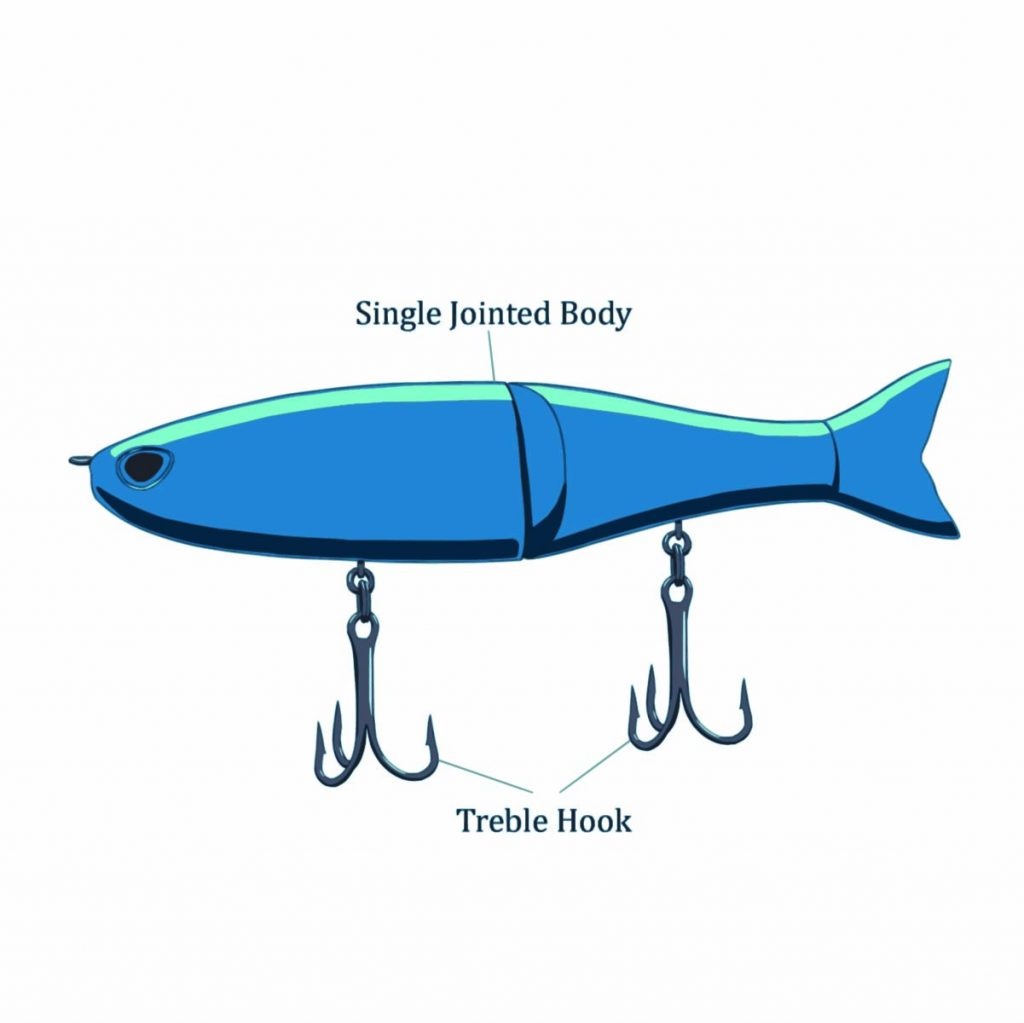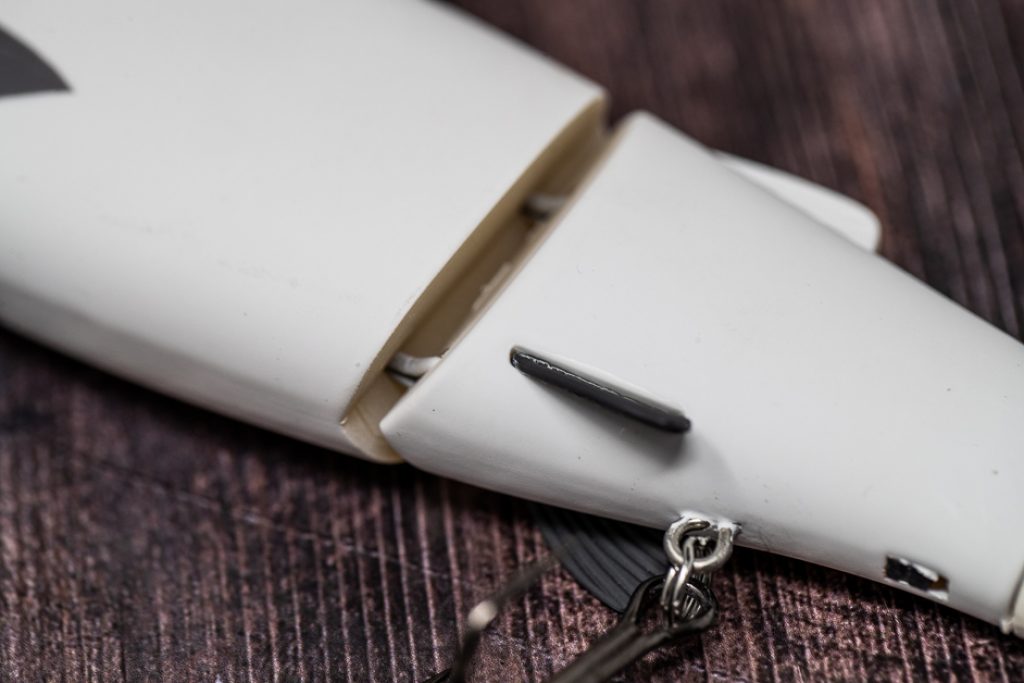Most bass fishing anglers will be aware of the most popular stretches of water close by to them that are more likely to get them a catch or two throughout their trip. However, while most are aware of the different types of ‘spoon’ or ‘lure’ to catch the bass, fewer of them are aware of the increasing popularity of a type of lure or ‘bait’ in bass fishing, known as glide bait fishing.
So, what are glide baits? How are they used, and how can you make the most out of using them?
This article will explore the world of glide baits for bass fishing so that any budding angler will be able to add them to their box of tricks when they take to the water.
What Are Glide Baits?
Glide baits were named after their unique action in the water. Using a slight rod tugging technique, these bait ‘glide’ from side to side with a swimming-like motion.
Unlike crankbait or swimbait, glide baits use their slender, single-jointed bodies to move in the water in a way that makes the bass strike. They are typically larger than most other types of lure or baits, with jumbo glide baits expected to attract larger bass to bite. They ‘swim’ with a wider ‘S’ shaped motion in the water and will pop or pull on a rod to cause the bait to glide and attract a bass to strike.
A glide bait’s action doesn’t come from an angler’s steady retrieve, but more so in their quick, sharp turns of the reel. Fishing with a glide bait is usually less about twitching and more about snapping. When in use, glide baits should be used as slow swimming baits, giving the fish more time to look at the lure. They have a hard body surrounding a tungsten ball in a spring that will vibrate in the throat of the bait giving subtle pressure waves that are easily detectable by a predator. Glide baits are available in several sizes and styles, but the bigger the glide bait used, the higher the chance of you being able to catch a bigger bass.
Best Glide Bait Setup
Here are some of the things you will need for your glide bait setup:
Rod:
You will need a glide bait rod that is suitable for swimming larger baits. However, the rod should have plenty of ‘give’ to keep a big fish from bending the hooks. Your rod should have great balance, backbone, and moderate action.
Reel:
The reel you choose will depend on your personal preference. Typically, round reels will work well with glide baits–as will low-profile reels. You need a larger reel for the line once you’re fishing.
Line:
A braided line with fluorocarbon leader is best for fishing glide baits because of the clear water. However, in water with a 5-10 feet visibility, you will want to use a 30-pound mono leader.
In the more extreme situations, you can use a 17-pound fluorocarbon line.
How to Fish Glide Baits
When it comes to the art of using glide baits to get a bite from a bass, there are multiple ways you can vary your retrieve and increase your chances of getting bit.
Glide baits do nothing more than glide around to lure bass in, but there are still several techniques to be aware of when fishing with them.
Slow Crawl:
All that’s needed is for you to just reel. The bait will do most of the hard work for you. Lure the glide slowly enough so that you can feel the lure at the end of the line. You need to show your lure swimming naturally. In doing this, the shadows formed behind the lure will let you know when it’s time to make a small turn to prompt the bass to be triggered by the bait and take a bite.
Stop and Go Twitches:
You might be able to catch a bass only by reeling it back and luring the glide slowly, but you can also get bites from ‘stop and go’ twitches that mimic fish near the bottom.
Remember that the retrieve is not being done with your rod tip but with the reel. Here, you will reel it, stop and paid, and then snap. This action will cause the lure to ‘S’ turn and glide. YOur reel turms should start off around a quarter of a turn and then up to half a turn.
If you find that the extra turns don’t give you the results you want, try to twitch your rod or raise it. By doing this the lure will start to behave differently. The bass will think the lure is trying to escape it causing it to bite.
When to Use Glide Baits
If you talk to any angler who specializes in bass fishing, you’ll hear many differences of opinion about when to use glide baits. However, some of the most important factors to consider are the water temperature and when spawn season is.
If we’re looking at water temperature, water that is in the low 50s is less likely to attract the fish using glide baits. Therefore, the higher the temperature, up the low 60s, glide baits will become even more effective.
However, it’s worth considering when fish spawn. Bass that have yet to spawn and those that are preparing themselves before going to the beds are more likely to attack glide bait. The reason for this is that at this time, they are more likely to be eating much more in preparation.
Post-spawners fish that are leaving their beds are more likely to attach to glide baits as their instincts will be telling them to eat.
In essence, there is no ‘wrong or right’ time to use glide baits for lure fishing since glide baits can be used most of the time in most places. Using glide baits can extent your abilities and possibilities when it comes to bass fishing.
Where To Use Glide Baits
Using glide baits will give you an added advantage when it comes to bass fishing. The main one being that the baits can be used as a tool to find fish- even if fish are not biting, it will show that there are fish there. That means you can go back to the same spot later on.
Reeds
Bass are most commonly found next to reeds. That’s why shallow places next to reeds are a good option for places to start- especially in Spring and Fall. Pay attention to when the lure leaves the reed area because when it changes direction toward where you are, that’s when you’re more likely to get the most bites.
Shelves
Shelves are also great places to use glide baits. You should try them in deep areas of water in shelf spots where you can go from either 5-15 feet or 15-30 feet. Having the opportunity to go deeper gives you the chance to catch more bass.
Best Glide Baits
Now that you have a better understanding of glide baits, you’re going to want to know where you can get hold of some for yourself.
When you’re on the market for glide baits, you need to find some that have the perfect balance and the perfect gliding action as a result. Having that perfect balance is crucial for keeping them upright in the water. This upright appearance keeps them looking like natural swimmers rather than rolling on their sides.
Here are some of the most popular tried and tested glide baits on the market:
River2Sea S-Waver
The most popular glides on the market. These slow-sinking baits have an excellent gliding action and come in three sizes. This mid-sized glide bait is the perfect target for bass of all sizes. However, for bigger bass, the S-Waver 200 is a great option for you.
Savage Gear Magnum Shine Glide
Another great option is the Savage Gear Magnum Shine Glide – Slow Sinking Lure. This bigger gliding bait is a little more expensive at just under $30 but these gliders typically have more flash in the water and a taller profile. These slow-sinking baits come in two different sizes and seven colors.
Or how about the hyper-realistic looking Gillman Glide Bait Bass Musky Striper Fishing Big Lure Multi Jointed Shad that gives you the choice of wither floating or sinking in a range of colors and different fish being represented?
As you have now learned, there are plenty of reasons for you to choose a glide bait as part of your bass fishing experience. With such a range on the market starting from a few dollars to almost $100, you can choose how much to invest in your glide bait to get the best results you can.




















